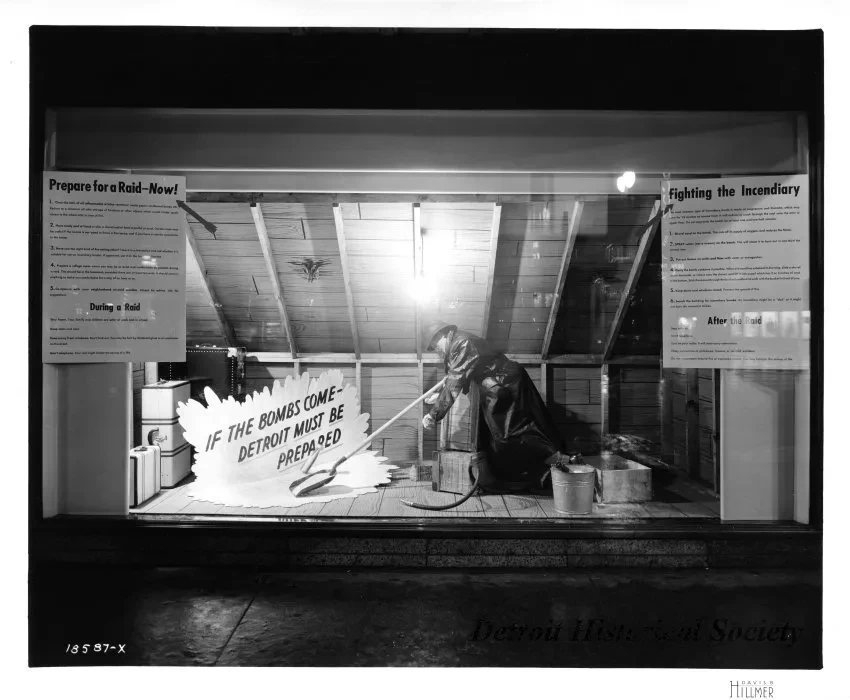Print, Photographic
Print. Black and white photographic print of a window display at the J.L. Hudson Company Department Store. Featured in the display is a mannequin dressed in a black trench coat, and hat with a shovel who appears to be scooping sand in an attic, after a bomb as come through the roof. Signage on the floor of the attic display reads, "If the bombs come - Detroit must be prepared." Signage on the left and right sides of the display allows for patrons to prepare themselves for the possibility of a raid and how to fight the incendiary. Signage on the left reads, "Prepare for a Raid-Now! 1. Clear the attic of all inflammable articles - excelsior, waste paper, cardboard boxes etc. Reduce to a minimum all attic storage of furniture or other objects which would hinder quick access to the whole attic in case of fire. 2. Have ready and at hand a rake, a shovel and at least a pailful of sand. Garden hose may be useful IF the nozzle is equipped to throw a fine spray, and if you have a nearby connection in the house. 3. Have you the right kind of fire extinguisher? Take it to a fire station and ask whether it is suitable for use on incendiary bombs. If approved, use it on the bomb as directed. 4. Prepare a refuge room where you may be as quiet and comfortable as possible during a raid. this should be in the basement, provided there are at least two exits. It should contain anything to make you comfortable for a stay of an hour or so. 5. Co-operate with your neighborhood air-raid warden. Accept his advice. Ask his suggestions. During a Raid. Stay home. Your family and children are safer at work and in school. Keep calm and cool. Keep away from windows. Don't look out. You may be hurt by shattering glass or an explosion on the street. Don't telephone. Your call might hinder the saving of a life." Signage in the upper right of the window display reads, "Fight the Incendiary. The most common type of incendiary bomb is made of magnesium and thermite, which may burn for 15 minutes at intense heat. It will ordinarily crash through the roof onto the attic or upper floor. Do not approach the bomb for at least one and one-half minutes. 1. Shovel sand on the bomb. This will cut off its supply of oxygen, and reduces the flame. 2. Spray water (not a stream) on the bomb. This will cause it to burn out in one-third the normal time. 3. Put out flames on walls and floor with water or extinguisher. 4. Carry the bomb outdoors if possible. When the sand has subdued its burning, slide a shovel under the bomb, or rake it on to the shovel, and lift it into a pail which has 2 or 3 inches of sand in the bottom. Stick the shovel through the bucket handle and walk with the bucket in front of you. 5. Keep doors and windows closed. Prevent the spread of fire. 6. Search the building for incendiary bombs. An incendiary might be a 'dud' or it might not burn the moment it strikes. After the Raid. Stay indoors. Don't telephone. Turn on your radio. It will soon carry instructions. Obey instructions of policeman, firemen, or air-raid wardens. Do not congregate around fire or explosion scenes. You may hamper the saving of life." The photographic sequence number and photographer's name are printed on the bottom of the recto, "18587-x; Davis B. Hillmer."
Request Image

